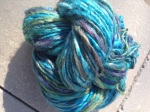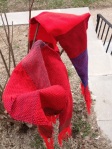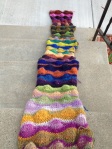I have managed to wash another 4 fleece samples.
The first is a Jacob. I think these are some really adorable sheep and the second fleece I purchased was from a Jacob.


Another Corriedale, this one grey.


Romney


Cormo


Disclaimer, this seems to me a rather unorganized post. I can’t figure out if I should tell you a story about what goes through my head during fleece prep or just give you facts. In the end, I fear I haven’t done either very well.
In my last sample fleece post, IntrovertedKnitter asked me this question:
“I haven’t had the pleasure of trying out raw fleece yet, but your samples are so enlightening as to the difference between before and after. I love the variety you have and can’t wait to see what you end up doing with it all. Aside from being able to go back a few more steps in terms of processing (which I can see the appeal)are there other reasons for starting with raw fleece?”
Well, I had to think it over and do a little reflection because I hadn’t really given it much thought before. It is just something I do. But there are reasons.
When I began spinning I thought I would never be interested in fleece processing. It sounded like such dirty hard work, and there was so little spinning involved. Then at some point, I got the idea in my head, as I do, and it stuck. In fact, it refused to let me rest from the time I started researching fleece processing rather intensely to the time I got my hands on a fleece to process. And even then I couldn’t rest until I started washing the fleece. Along the way, I realized I was having a crazy good time with it all and so it stuck. And it grew from there. I guess you could say I started processing on a bit of a whim and then realized just how fun and obsessive it could be. But that still doesn’t answer the question why.
After 4 years of spinning , combed top and batts all started to look the same. I couldn’t get too excited over color anymore as I’d seen most color combinations before and it was a whole lot of same fiber different day. I felt that I’d seen it all and done it all. This was false actually, as it took another 2 years for me to spindle spin, support spindle spin, corespin, spin bulky, etc. But to be honest, I was a little bored with my spinning. Prior to this, my obsession with fiber was like my obsession with yarn, it was all about the color.
But then, all of a sudden, natural colors began to appeal to me in a huge way. And that was when fleece became very interesting. I’ve rarely wanted to dye fleece I’ve prepped, because I love the color that happens in nature.
When it comes to commercial wool, you are limited in what fibers you get to try. So there’s merino, BFL, polwarth, various superwashes, various basics blended with silk, bamboo, or tencel, but as far as the huge variety of wool out there? Commercial wool is limiting. Plus, with it being already prepped commercially, it is hard to get a good idea of how that wool naturally acts. Yes, polwarth is bouncy and BFL is a crimpy longwool, but so often you spin something commercially expecting it to act one way, just to wash it, release it into a more natural state, and it behaves differently than expected. This is a perfectly valid way to spin, but I got to the point where I wanted to understand how these wools acted from the start.
In addition to that, it is awfully hard to find the rarer breeds in commercial top. Even Romney, a longwool fairly popular, isn’t often seen in commercial dyed prep. Never mind Racka, Navajo churro, and a whole host of longwools that are very interesting. Now, it makes sense. After all, breeds like Racka and Navajo Churro are not for sweater or close to skin wear, but they are still interesting and serviceable wools and I have a great desire to explore each of them as much as I can.
There’s an element of learning to it as well. My process is that I end up with a breed of wool I am unfamiliar with, and then I am forced to research how it might act, what the best prep for it might be, what it is best used for, etc. All that is highly interesting for me, I enjoy that part of the process. And then I get to spin it and see how it feels in my own hands and if my experiences are consistent with the going wealth of knowledge.
It gives me a great respect for the differences in each breed as well. For instance, my first experience with Border Leicester, a longwool, was with one that was extremely wiry. You wouldn’t want that anywhere near your skin, and you might not want it on the outside either! Then I got some super cheap Border Leicester, washed that up, and it was the softest longwool I’ve ever encountered. It depends on the sheep as well as the breed, I was amazed at how large a difference it was.
Processing your own fleece gives you the opportunity to design your yarn and garment from start to finish. You wash, you flick card, you decide you you will prep that wool according to how the wool is acting, you’ve got enough to make samples, then you spin your yarn with intention. Then you get to knit or weave the garment that you imagined when you began the entire process. That’s a pretty wild feeling.
I truly enjoy each step of the process. I love watching wool go through its transformation from greasy dirty locks to beautiful yarn. It is extremely appealing and interesting and while I believed at one time certain parts of the process would bore me, I find that it does not. I like to flick card, I like getting all the junk out of the locks. I like to hand card and throw it all through the drum carder. I don’t have wool combs yet, but I’ve played with them a bit and I feel confident that I’d love having them too. And then when all is said and done, I still get to spin that wool.
There’s something to be said for having a few spinning years under my belt as well. When I began spinning I was in a rush to spin all the things. Now I don’t mind if the process takes a good amount of time. As long as I am enjoying myself I am happy with the time it takes.
I suspect fleece prep is a highly individualized thought process. I, personally, have tried to send fleece to a mill before. I’ve even gone so far as to box it up and fill out the appropriate paperwork. But in the end, I can’t let it out of my sight! In the end, I feel that sending it to a mill is going to ruin my fun, even with a dirtier, VM full fleece. While sending a fleece to a mill is a perfectly valid option, for me it feels a bit “What’s the point?” Mostly because I buy fleece because I want to be involved in the process from start to finish.
So I suppose, for me, the reason I prep fleece has something to do with the desire to research and understand my craft better and more fully. I will never be an expert, but I do want to be as knowledgeable as possible. I need the hands on process of prepping my own fleece in order to do that, because that is just how I learn. While all other options are valid, fleece prep is the best option for how I learn and how I enjoy what I spend my free time on.
Anyone else out there want to weigh in on this? Why do you prep fleece? What is the thought process that you have and how did you come to decide you wanted to take on such a thing?























































